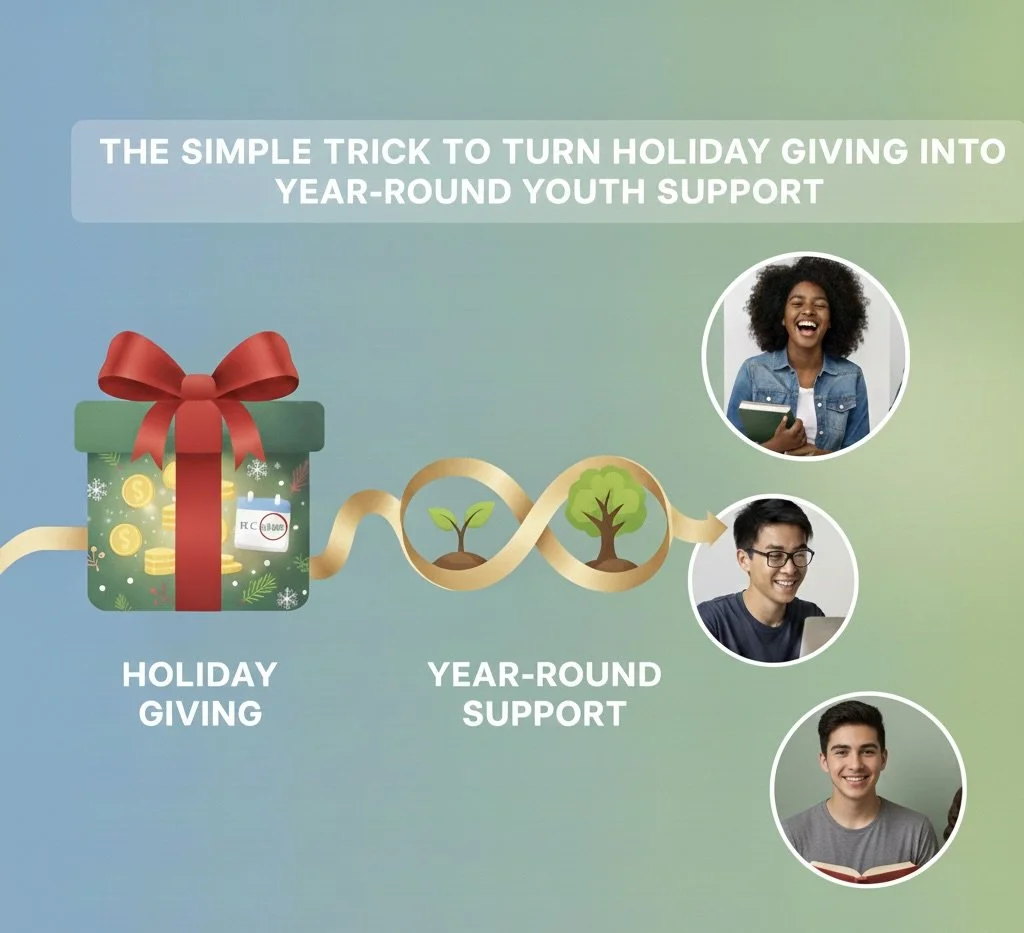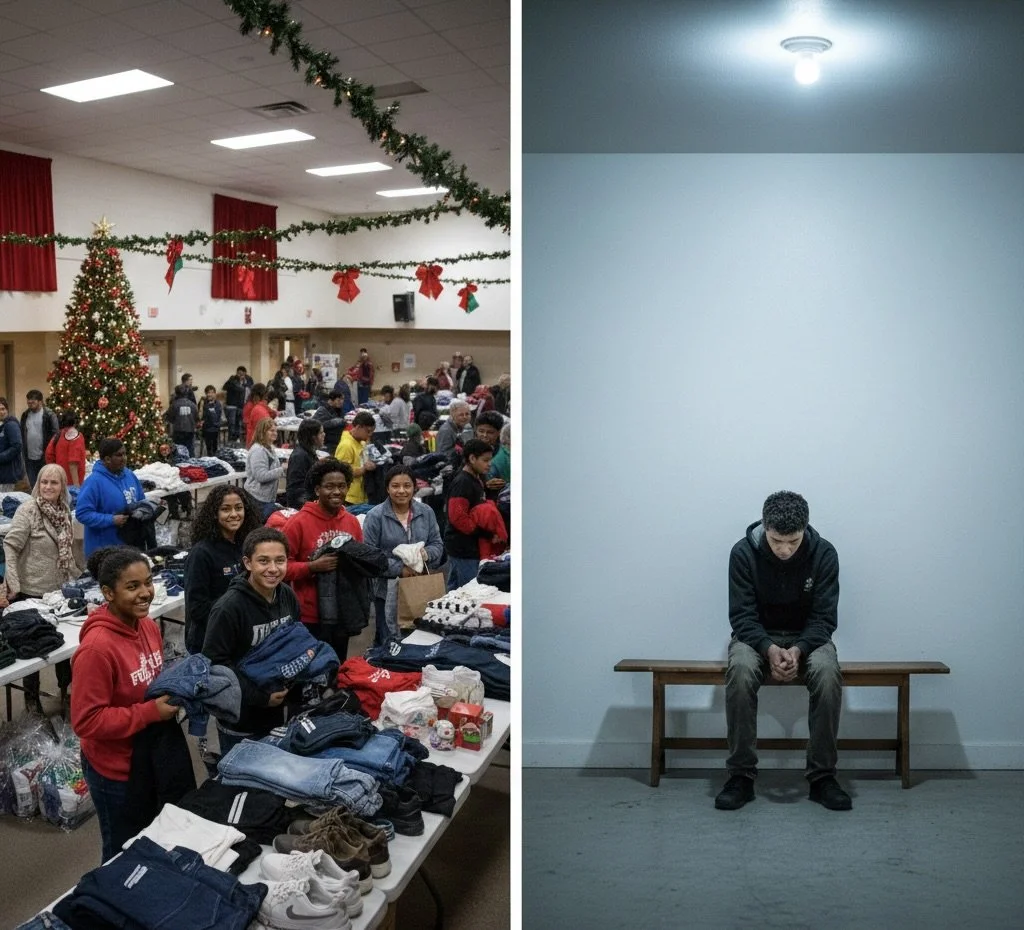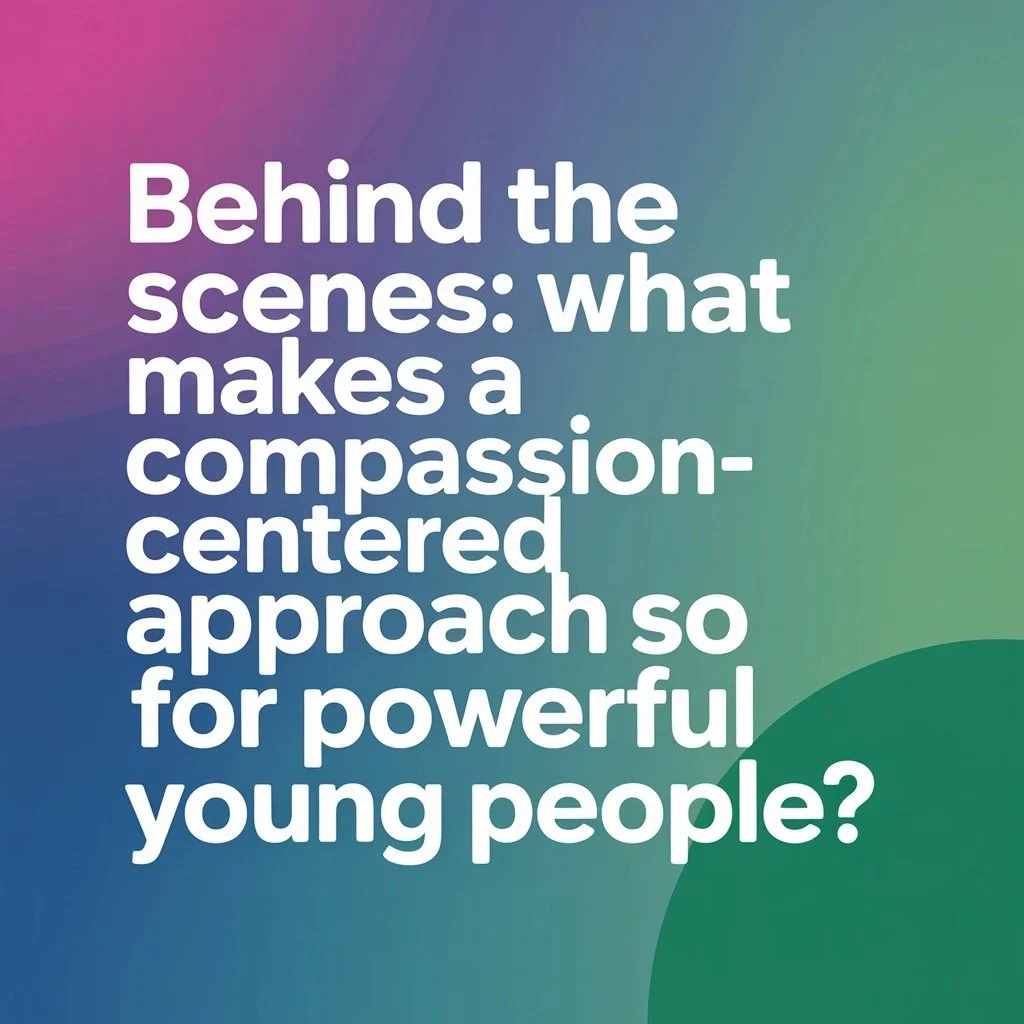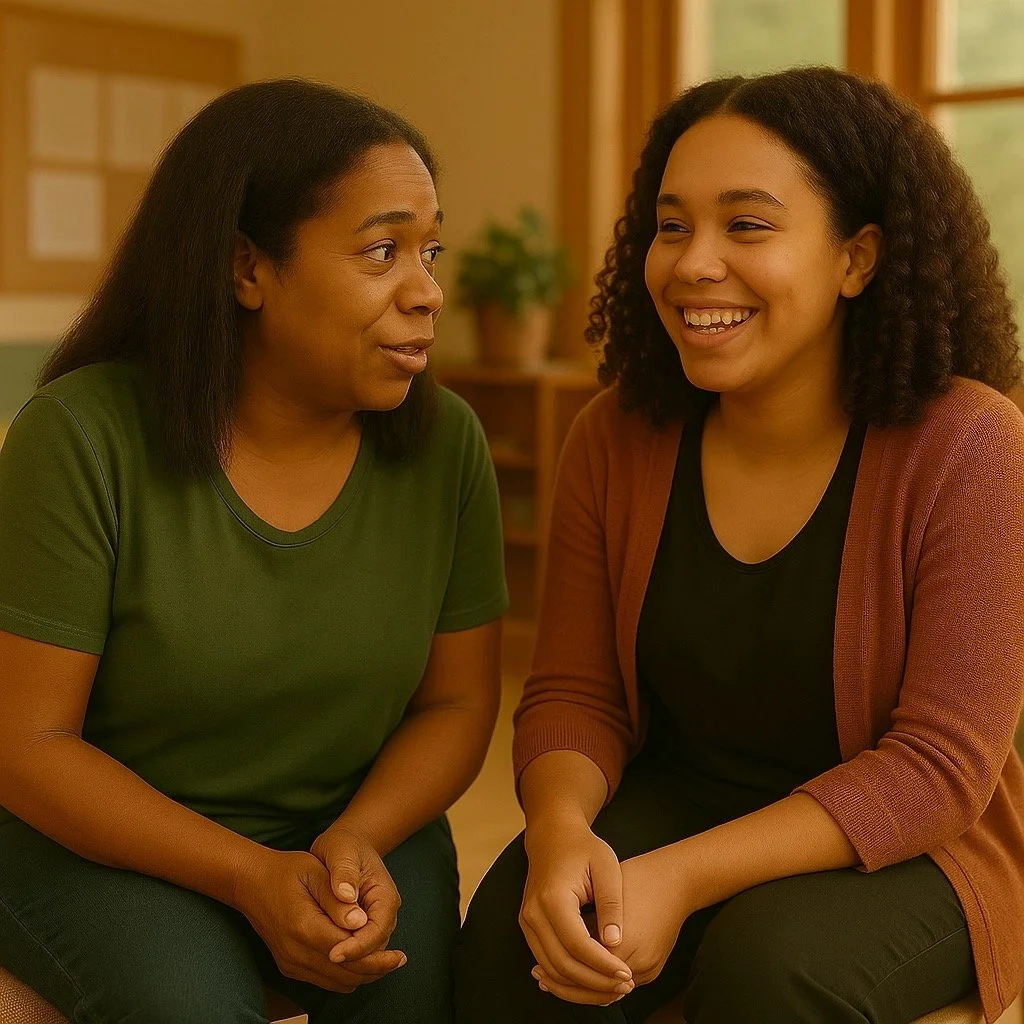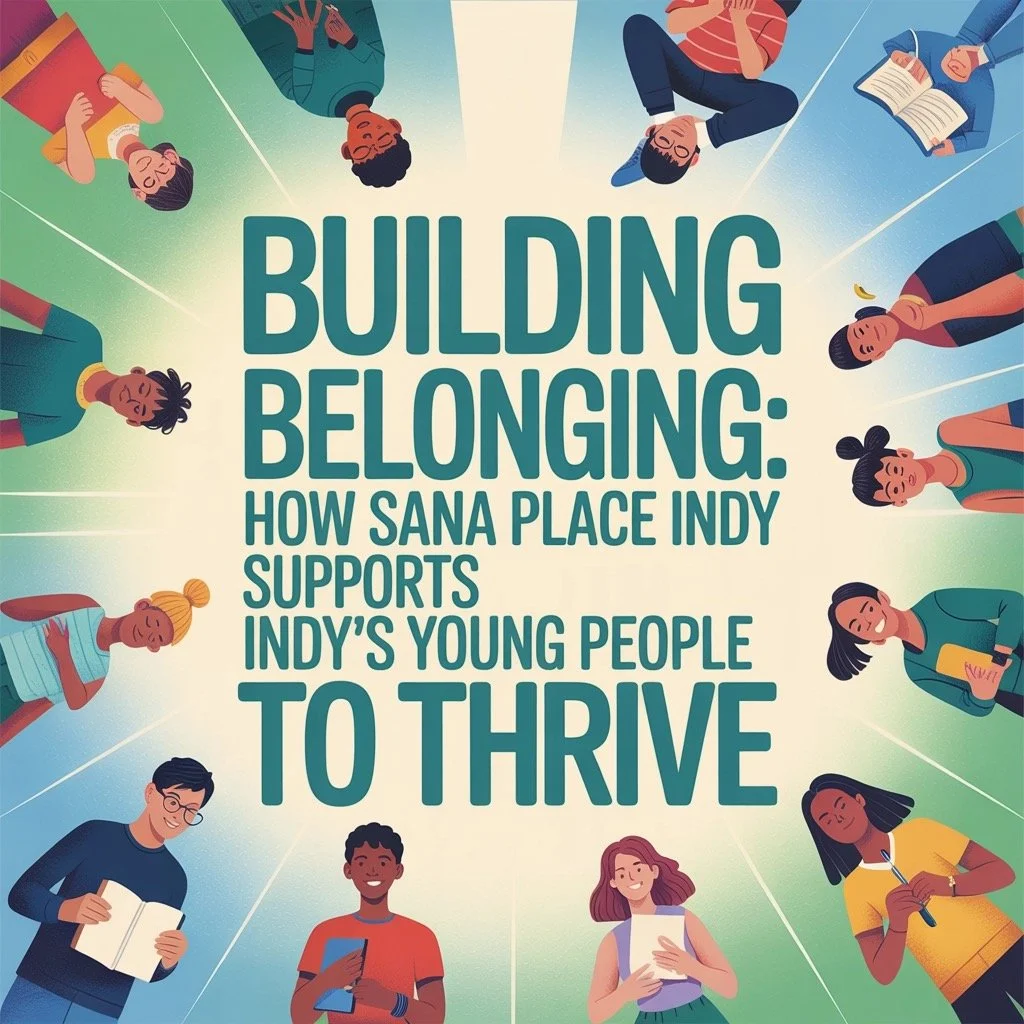The Simple Trick to Turn Holiday Giving Into Year-Round Youth Support
Every December, something amazing happens. Hearts open wider, wallets get more generous, and people start thinking about how they can help those in need. Food drives pop up at offices, toy collections fill community centers, and donation drives flood social media feeds. It's beautiful: and it's also temporary.
Here's the thing about homelessness, trauma, and the challenges facing young people today and that is that they don't take a holiday break. A teenager aging out of foster care needs support in February just as much as they do in December. A young person experiencing housing instability requires help finding stable employment in July, not just during the "season of giving."
So how do we bridge that gap? How do we turn the incredible generosity of the holiday season into something that lasts all year long? The answer is simpler than you might think.
The Holiday Giving Paradox
We've all seen it happen. November rolls around, and suddenly everyone's talking about helping those in need. December hits, and donation boxes are overflowing. January arrives, and... silence. The need doesn't disappear when the decorations come down, but the support often does.
This seasonal spike in giving creates what experts call the "charity cliff": a dramatic drop in donations and volunteer support that happens right after the holidays. For organizations supporting vulnerable youth, this pattern can be devastating. Just when young people need consistent, reliable support to build stable lives, the resources dry up.
The irony? The skills, relationships, and progress that young people build during those high-support winter months need nurturing throughout the entire year to stick. Imagine learning to ride a bike but only getting to practice in December. That's what seasonal support can feel like for youth trying to build life skills and stability.
The Simple Trick That Changes Everything
Here's where the magic happens. Instead of treating holiday giving as a one-time event, successful organizations use it as a gateway to year-round engagement. They don't just ask for December donations, they invite people into ongoing relationships with their mission.
The trick? Frame holiday giving as the first step in a year-long journey, not the final destination.
Instead of saying "Help us provide holiday meals for homeless youth," try "Help us launch a year-long nutrition program that starts with holiday meals and continues with cooking classes, food assistance, and nutrition education throughout the year."
Instead of collecting winter coats in December, create a clothing closet that operates year-round, with the holiday drive serving as the kickoff event that stocks it for the entire year.
This shift in framing transforms one-time donors into ongoing supporters because they can see the bigger picture of how their holiday gift creates lasting change.
How Organizations Make It Work
Smart youth-serving organizations have figured out how to make this transition seamless. They use holiday campaigns to introduce people to their year-round programs, then provide multiple touchpoints throughout the year to keep supporters engaged.
Take mentoring programs, for example. Many organizations launch their annual mentor recruitment during the holidays, when people are already thinking about giving back. They host holiday parties where current mentors and mentees can share success stories, showing potential volunteers the long-term impact of their programs. New mentors who sign up in December are then supported and engaged throughout the entire year.
Workforce development programs often use a similar approach. Holiday fundraising might support job training programs that run continuously. Donors who give in December receive updates in March about the young person who landed their first job, in June about someone completing their GED, and in September about a program graduate starting college.
The key is creating what one youth worker calls "sticky connections": ways for supporters to stay connected to the cause beyond their initial holiday gift. This might include:
Monthly newsletters featuring success stories
Volunteer opportunities spread throughout the year
Skill-specific ways to help (offering resume workshops, mock interviews, or career mentoring)
Social events that bring supporters together with program participants
Why Year-Round Support Actually Works Better
Research consistently shows that sustained, long-term support creates better outcomes for young people than intense, short-term interventions. Think about it from a young person's perspective: what's more helpful: having dozens of people care about you for one month, or having a smaller group of people consistently support you for an entire year?
Young people aging out of foster care, for instance, need help with everything from finding housing to building credit to learning how to manage healthcare. These aren't skills you can master in a weekend workshop: they require ongoing support, practice, and encouragement over months and years.
The same goes for educational support. A holiday gift of school supplies is wonderful, but what really changes outcomes is having consistent tutoring, mentoring, and encouragement throughout the school year. Academic success happens one assignment, one test, one semester at a time.
Mental health support follows the same pattern. While crisis intervention is crucial, the real healing happens through consistent therapy, peer support groups, and stable relationships that persist through good times and bad times alike.
Practical Steps to Make the Shift
Ready to turn your holiday giving into year-round support? Here's how to start:
For Individual Donors:
Instead of making a one-time December donation, set up a monthly recurring gift that spreads your holiday donation across the entire year
Ask organizations how your holiday gift connects to their year-round programs
Sign up for volunteer opportunities beyond the holiday season
Follow organizations on social media and engage with their year-round content
For Organizations:
Design holiday campaigns that explicitly connect to year-round programming
Create donor communication plans that extend well beyond December
Offer multiple engagement opportunities throughout the year
Track and share long-term outcomes, not just holiday season metrics
For Employers and Community Groups:
Instead of annual holiday drives, consider ongoing partnerships with youth-serving organizations
Offer employee volunteer opportunities year-round
Sponsor specific programs or staff positions rather than just holiday events
Building Relationships That Last
The most successful programs don't just ask for money or donations: they invite people into relationships. They help supporters understand that supporting youth isn't about giving things to people; it's about walking alongside young people as they build skills, overcome challenges, and create positive futures.
This relationship-based approach transforms how people think about giving. Instead of feeling good about a December donation and moving on, supporters become invested in ongoing outcomes. They start asking questions like "How is Marcus doing in his job training program?" and "Did Sophia get into the college she was hoping for?"
When supporters feel personally connected to the young people they're helping, seasonal giving naturally evolves into year-round commitment. The holiday spirit: that sense of connection, generosity, and hope: doesn't have to end on January 1st.
The Ripple Effect
When holiday giving becomes year-round support, something beautiful happens: the impact multiplies. Young people who receive consistent support are more likely to succeed, and successful young people often become mentors and supporters themselves. The college student who received tutoring support throughout high school comes back to volunteer. The young person who found stable housing through your program refers their friends who need help.
This creates what researchers call "positive feedback loops": cycles where good outcomes create more good outcomes. Year-round support doesn't just help individual young people; it strengthens entire communities.
Your Role in the Solution
The truth is, we don't need more holiday charity. We need more year-round community. We need supporters who understand that real change happens slowly, through consistent relationships and ongoing support.
Whether you're someone who gives during the holidays, volunteers at community events, or works with young people professionally, you have the power to make this shift. Instead of asking "How can I help during the holidays?" try asking "How can I help create positive change that lasts all year long?"
At Sana Place Indy, we've seen firsthand how sustained support transforms lives. The young people in our programs don't need saviors showing up once a year: they need community members who commit to walking alongside them through their entire journey toward stability and success.
The simple trick to turning holiday giving into year-round support isn't really a trick at all. It's about recognizing that the best gift we can give vulnerable young people isn't seasonal generosity: it's enduring commitment to their success.
Ready to make that shift? Learn more about how you can get involved with year-round support that truly makes a difference.
Why Compassionate Shelter Standards will Change How We support Vulnerable Youth
The landscape of youth homelessness support is undergoing a revolutionary transformation. Gone are the days when shelter meant just four walls and a roof. Today's compassionate shelter standards are reshaping how we approach vulnerable youth, moving from a basic survival model to one that truly nurtures healing, growth, and long-term success.
What Are Compassionate Shelter Standards?
Compassionate shelter standards represent a fundamental shift in how we think about supporting homeless and at-risk youth. Instead of simply providing temporary housing, these standards emphasize dignity, respect, and comprehensive care that addresses the whole person: not just their immediate housing needs.
These standards recognize that youth experiencing homelessness often face complex, interconnected challenges. They might be dealing with family conflict, mental health issues, educational disruptions, or discrimination based on their identity. A compassionate approach means meeting young people where they are, without judgment, and providing wraparound services that address all aspects of their well-being.
Breaking Down Barriers to Access
One of the most significant changes in compassionate shelter standards is the elimination of barriers that traditionally prevented youth from accessing help. The old model often required extensive documentation, had lengthy intake processes, or imposed strict eligibility criteria that could leave the most vulnerable youth without support.
Today's compassionate standards prioritize immediate safety over bureaucratic requirements. This means accepting youth into programs without requiring third-party documentation upfront, recognizing that in crisis situations, having the proper paperwork is far less important than ensuring a young person has a safe place to stay.
Many programs now operate on a "low-barrier" or "no-barrier" approach, understanding that when a teenager shows up at your door at 2 AM, the priority is getting them inside and safe: everything else can be sorted out later. This shift saves lives and builds trust between youth and service providers.
The 24/7 Crisis Response Revolution
Traditional shelter models often operated during business hours, leaving youth vulnerable during evenings, weekends, and holidays when crises don't conveniently pause. Compassionate shelter standards have revolutionized this approach by implementing 24/7 crisis intervention systems.
This around-the-clock availability means that when a young person experiences a family crisis, faces immediate danger, or finds themselves without a place to stay, help is always just a phone call away. Emergency response systems can mobilize quickly, connecting youth with safe shelter options regardless of the time or day.
The impact of this change cannot be overstated. Youth homelessness often begins with a moment of crisis: a family argument that escalates, an eviction notice, or a dangerous situation that requires immediate escape. Having compassionate support available 24/7 can be the difference between a young person ending up on the street or being connected to the help they need.
Creating Truly Inclusive Environments
Perhaps one of the most important aspects of compassionate shelter standards is the commitment to creating inclusive, welcoming environments for all youth, regardless of their identity, background, or circumstances. This is particularly crucial for LGBTQ+ youth, who face disproportionately high rates of homelessness due to family rejection and discrimination.
Compassionate standards require shelters to explicitly welcome youth of all gender identities, sexual orientations, and expressions. This isn't just about having a non-discrimination policy on paper: it's about creating an environment where all youth feel safe, respected, and valued.
Staff training becomes crucial in this model. Workers learn to use affirming language, respect chosen names and pronouns, and understand the unique challenges faced by different populations of youth. The goal is to ensure that every young person who walks through the door feels seen and accepted for who they are.
Moving Beyond Basic Needs
While traditional shelters focused primarily on providing food and shelter, compassionate standards take a holistic approach that addresses the full spectrum of a young person's needs. This means integrating services like healthcare, mental health support, educational assistance, legal advocacy, and life skills training all under one roof or through strong community partnerships.
Healthcare integration is particularly important, as many homeless youth have gone without proper medical care and may have urgent health needs. Mental health support recognizes the trauma that many youth have experienced and provides counseling and therapeutic services to help them heal and move forward.
Educational support ensures that homelessness doesn't derail a young person's academic progress. This might include helping youth enroll in school, providing tutoring, or connecting them with alternative education programs that fit their circumstances.
Prioritizing Family Connections When Safe
Compassionate shelter standards recognize that family relationships, when healthy and safe, are often crucial to a young person's well-being and success. Rather than automatically assuming family separation is permanent, these standards emphasize family reunification and stabilization when appropriate.
This approach includes conflict mediation services that can help address the issues that led to a youth's homelessness in the first place. Sometimes, what initially appears to be an insurmountable family crisis can be resolved with proper support and intervention.
However, these standards also recognize that family reunification isn't always safe or appropriate. In cases where returning home would put a youth at risk, the focus shifts to helping them develop other supportive relationships and connections that can provide the stability and guidance they need.
Building Pathways to Independence
While addressing immediate needs is crucial, compassionate shelter standards also focus heavily on long-term outcomes and helping youth develop the skills and connections they need to achieve independence and stability.
This might include job training programs, financial literacy education, assistance with obtaining important documents like birth certificates or ID cards, and help navigating systems like healthcare or higher education. The goal is to ensure that when youth transition out of shelter, they have the tools and support networks they need to maintain housing and continue building their lives.
Career development and educational support play crucial roles in this process. Many programs now include partnerships with local employers, internship opportunities, or connections to vocational training programs that can help youth develop marketable skills.
The Ripple Effect on Communities
When we implement compassionate shelter standards, the benefits extend far beyond the individual youth being served. Communities that embrace these approaches often see reduced crime rates, improved public health outcomes, and stronger social cohesion.
Youth who receive compassionate, comprehensive support are more likely to become contributing members of their communities. They're more likely to complete their education, find stable employment, and develop healthy relationships. This creates a positive cycle that benefits everyone.
Additionally, these standards often require stronger collaboration between different service providers, creating more effective support networks throughout the community. When organizations work together with a shared commitment to compassionate care, the entire system becomes more effective.
Measuring Success Differently
Compassionate shelter standards also change how we measure success in youth homelessness programs. Rather than focusing solely on metrics like bed occupancy rates or length of stay, these approaches emphasize outcomes like family reunification rates, educational achievement, mental health improvements, and long-term housing stability.
This shift in measurement encourages programs to focus on what really matters: the long-term well-being and success of the young people they serve. It also helps funders and community leaders understand the true impact of their investments in youth services.
What This Means for Our Future
The movement toward compassionate shelter standards represents more than just a change in how we run homeless shelters: it's a fundamental shift in how we value and support young people in our communities. By embracing these standards, we're acknowledging that every youth deserves dignity, respect, and the opportunity to heal and grow.
As more communities adopt these approaches, we're likely to see significant improvements in outcomes for vulnerable youth. This means fewer young people experiencing chronic homelessness, better educational and employment outcomes, and stronger, more resilient communities overall.
The transformation isn't always easy or quick, but the results speak for themselves. When we approach vulnerable youth with compassion, understanding, and comprehensive support, we give them the foundation they need not just to survive, but to thrive. And that makes all the difference: not just for them, but for all of us.
At Sana Place Indy, we're committed to being part of this transformation, working every day to ensure that the young people in our community receive the compassionate, comprehensive support they deserve.
Homelessness is Rising for Young People and Here’s What You Can Do
Homelessness Is Rising for Young People and Here’s What You Can Do About It
If you live in Indianapolis, or really, anywhere in the US, it’s impossible to ignore the headlines: More young people are experiencing homelessness than ever before. The increase is not just a statistic; it’s a daily reality, right here in our neighborhoods. It’s kids couch-surfing at friends’ homes, teens spending the night in cars, and families doing everything they can to avoid sleeping on the street. This blog digs into why youth homelessness is rising and, more importantly, what we can do to help.
The Scope of the Crisis
Recent studies show nearly 150,000 children were homeless on a single night in 2024, a stunning 33% jump from the previous year. That’s the largest increase for any age group nationwide. And that number only counts the visible cases, kids in shelters or known to agencies. Many more bounce between unstable living situations, unseen and uncounted.
And the issue is even bigger when you look at teens and young adults. In the US, as many as 4.2 million young people will experience homelessness this year. Many are alone, some with their families, and some as young as middle schoolers. It’s an all-hands-on-deck situation, because every night on the street is a risk to their safety, health, and future.
What’s Behind These Alarming Numbers?
It’s tempting to search for one root cause, but youth homelessness is a tangled web. Here’s what’s feeding the crisis:
Lack of Affordable Housing: Rents have skyrocketed while wages remain flat. Families living paycheck-to-paycheck can be pushed into homelessness by a single missed payment, a medical emergency, or even a landlord deciding to sell.
End of Pandemic Safety Nets: During COVID-19, programs were put in place to prevent homelessness, like eviction moratoriums and expanded child tax credits. Many of those supports have expired, leaving families exposed to economic shocks.
Systemic Inequities: Black and African American youth face homelessness at much higher rates. They make up just 12% of the US population but represent 32% of homeless youth.
Family Instability: Conflict, neglect, or rejection at home (especially for LGBTQ+ teens) pushes many toward the streets. In some cases, young people leave to escape abuse or trauma and have nowhere else to go.
Mental Health and Substance Use: Homelessness and mental health issues often go hand-in-hand, with one worsening the other. Limited access to affordable care compounds the problem.
When so many forces collide, it’s easy for a young person, or a whole family, to fall through the cracks.
How Organizations Like Sana Place Indy Make a Difference
There’s no single solution, but there are proven ways to help kids and teens get off the streets and build bright futures.
At Sana Place Indy, our focus is simple: meet young people where they are, treat them with compassion, and create pathways to stability. That means:
Emergency beds and safe spaces so no young person has to sleep outside.
Support Services: Wraparound help, from mental health support to tutoring, job training, and life skills workshops.
Trusted Relationships: Every youth needs an adult who listens and believes in them. Our staff and volunteers are trained to offer “unconditional love, absolute respect, and relentless support.” (Learn more about our mission at https://www.sanaplaceindy.org/about About Sana Place Indy.)
We’re not the only ones. Other orgs like Covenant House and local centers like Trinity Haven and 91 Place and others across the nation provide continuous shelter, meals, and care, helping thousands of youth get the footing they need to rebuild.
Here’s What You Can Do to Help
It’s easy to feel powerless in the face of these numbers, but your actions matter, maybe more than you think. Here are real ways to support youth experiencing homelessness, right here in Indy, or wherever you live:
1. Donate (Regularly, If Possible)
Monthly giving can make more impact than you imagine. Many organizations, including Sana Place Indy and Covenant House, rely on predictable gifts to keep beds open and programs running smoothly. Even $10 or $20 a month can fuel year-round care for youth in crisis.
Want to chip in? https://www.sanaplaceindy.org/gift-of-hope Make a gift or become a monthly supporter.
2. Volunteer Your Time and Talents
Shelters and youth support organizations are always looking for caring adults to help out, whether that’s serving meals, tutoring, helping with special events, or lending professional skills. Got extra time, patience, or expertise? There’s a role for you.
Ready to get started? https://www.sanaplaceindy.org/get-involved See how you can get involved at Sana Place Indy.
3. Be an Advocate for Change
Systemic problems need systemic solutions. You can help by contacting your local representatives and asking them to:
Expand affordable housing programs
Raise the minimum wage
Increase funding for mental health, youth outreach, and family supports
Watch for city council meetings or local initiatives related to housing or youth support. One letter or call really does make a difference.
4. Donate Thoughtfully Not Just “Stuff”
Blankets and clothes are helpful, but shelters need cash and gift cards for their biggest impact. Financial donations allow programs to target needs and respond quickly to urgent situations.
If you want to donate supplies, ask your local center what’s most needed. Hygiene kits, socks, and non-perishable snacks often top the list.
5. Support Prevention, Not Just Emergency Response
Preventing homelessness in the first place is powerful. Programs that offer rental assistance, family mediation, or crisis counseling are some of the most effective, but also the least flashy and most under-resourced.
Spread the word about these programs and consider designating gifts or volunteer time to organizations focused on prevention.
6. Learn and Share What You Learn
The more we talk about youth homelessness, the harder it is to ignore or dismiss. Share the facts with your network: at work, at school, or online. Challenge harmful myths. Invite friends to support or volunteer together.
Start conversations that’s when real change starts when we all see these young people as our own kids, neighbors, and classmates.
Why It Matters and And Why Now
Youth are more than a number. Each one shines with potential—a future artist, nurse, teacher, or entrepreneur in our city. When we step up for them, we build a more hopeful, resilient Indy for everyone.
Here at Sana Place Indy, we see the impact every day—a warm meal, a safe bed, a supportive conversation can be the first step on a new path.
If you want to learn more about how your support changes lives, check out our youth stories at https://www.sanaplaceindy.org/our-voices-our-journey Our Voices, Our Journey
The need is urgent, but the solutions are within reach, especially if we all play our part. Let’s make sure every young person in Indy has a place to call home and a community that believes in them.
If you or someone you know needs help, visit https://www.sanaplaceindy.org/help Help Page for resources and next steps.
A COmpassion-centered approach
It all begins with an idea.
The Foundation of Connection
In a world where young people navigate unprecedented challenges, from social media pressures to economic uncertainty, how we approach youth support matters more than ever. At Sana Place Indy, we've witnessed firsthand how compassion transforms lives, but what exactly makes this approach so effective?
Let's pull back the curtain and explore why compassion isn't just a nice sentiment, it's a powerful, evidence-based strategy that creates lasting change for the young people we serve.
What Do We Mean by "Compassion-Centered"?
Before diving deeper, let's clarify what we're talking about. A compassion-centered approach goes beyond simple kindness. It involves:
Intentional presence – Being fully there with young people without judgment
Authentic connection – Creating relationships based on genuine understanding, not authority
Trauma awareness – Recognizing how past experiences shape current behaviors
Empowerment focus – Building resilience rather than dependency
This approach stands in stark contrast to compliance-focused or purely clinical models that sometimes miss the human element at the heart of healing.
The Science: Why Compassion Works for Young Brains
Recent neuroscience research confirms what many youth workers have intuitively known: compassion creates biological changes that support healing and growth.
When young people experience genuine compassion, their brains release oxytocin, often called the "connection hormone", which reduces stress and promotes trust. This is particularly significant because many youth experiencing homelessness or trauma operate in a constant state of fight-or-flight, with elevated cortisol levels that impair decision-making and emotional regulation.
A 2022 study found that compassion-focused interventions significantly reduced symptoms of depression and anxiety in adolescents while improving self-esteem. The research shows these approaches work because they address a fundamental human need for connection that becomes even more crucial during adolescence and young adulthood.
Three Core Elements That Make Compassion Transformative
1. Creating Safety in Uncertainty
For young people facing housing instability or other challenges, life often feels chaotic and unpredictable. Compassion-centered environments provide consistency and psychological safety, essential prerequisites for any meaningful growth.
"When I first came to Sana Place, I was constantly looking over my shoulder," shares one young person who accessed our services. "Having staff who didn't judge me or rush me to 'get better' made all the difference. I could finally breathe enough to think about my future."
This psychological safety isn't about coddling, it's about creating the necessary conditions for young people to engage with difficult emotions and situations from a place of security rather than survival.
2. Modeling What Healthy Relationships Look Like
Many youth we work with have experienced relationships characterized by inconsistency, conditional acceptance, or exploitation. A compassion-centered approach demonstrates what healthy connections look and feel like.
When staff maintain boundaries while showing unconditional positive regard, young people learn through direct experience that relationships can be supportive without being transactional. This modeling happens through countless daily interactions, from respecting privacy to honoring preferences to following through on commitments.
The impact extends beyond the immediate relationship. As young people internalize these experiences, they become more capable of forming healthy connections in other areas of their lives.
3. Shifting from "What's Wrong?" to "What Happened?"
Traditional approaches often begin by identifying deficits, diagnosing problems, or categorizing behaviors. Compassion-centered work starts differently by asking: "What happened to you?" rather than "What's wrong with you?"
This subtle shift recognizes that challenging behaviors or struggles are often adaptive responses to difficult circumstances, not character flaws or pathologies.
"When people look at homeless youth, they see problems to fix," explains a member of our team. "When we lead with compassion, we see young people with incredible resilience who've survived situations most adults couldn't imagine. That perspective changes everything about how we work together."
Breaking Through Resistance and Building Trust
One of the most powerful aspects of compassion-centered approaches is their effectiveness with young people who've been resistant to traditional services.
Many youth arrive at our doors after negative experiences with systems designed to help them. They've learned to be guarded, skeptical, and sometimes outright resistant—with good reason. These are protective strategies that have helped them survive.
Compassion works where other approaches fail because it doesn't demand trust upfront. Instead, it earns trust gradually through consistency, respect, and authentic care. This is especially important for young men, who often face cultural expectations to handle problems independently and may view seeking help as a sign of weakness.
"I didn't want anything to do with another program," one young man told us. "But this felt different from day one. No one was trying to 'fix' me or tell me how to live. They just showed up, consistently, even when I wasn't at my best."
How Compassion Addresses Unique Developmental Needs
Young adulthood is a distinct developmental stage with specific psychological needs. Compassion-centered approaches are uniquely suited to address these needs because they:
Honor autonomy while providing support
Recognize identity exploration as essential work, not a distraction
Accept non-linear progress rather than expecting continuous improvement
Validate emotional experiences without minimizing or amplifying them
This developmental alignment explains why compassion-centered approaches resonate so deeply with young people. They feel seen and respected in their journey rather than processed through a system.
The Ripple Effect: Beyond Individual Impact
The power of compassion extends beyond individual healing. When young people experience compassion-centered support, it creates a ripple effect:
Peer influence: Young people begin modeling compassionate approaches with each other, creating positive community norms.
Future relationships: As they internalize healthy relationship patterns, they bring these forward into their romantic, familial, and professional relationships.
Community connection: Young people who feel genuinely cared for are more likely to develop their own sense of care for the broader community.
At Sana Place Indy, we see this ripple effect in action when former participants return as volunteers, mentors, or advocates—demonstrating how compassion received becomes compassion shared.
Challenges and Misconceptions About Compassion-Centered Work
Despite its effectiveness, compassion-centered work faces misunderstandings:
Misconception #1: "Compassion means no boundaries or consequences."
Reality: Authentic compassion includes clear, consistent boundaries. In fact, maintaining appropriate boundaries is itself an act of compassion that helps young people develop healthy expectations of relationships.
Misconception #2: "It's too 'soft' an approach for 'tough' cases."
Reality: Compassion requires tremendous courage and resilience from staff, especially when working with young people who test relationships through challenging behaviors. It's often the most demanding approach, requiring staff to regulate their own reactions while staying connected.
Misconception #3: "It's just being nice."
Reality: Compassion-centered work is strategic and intentional, grounded in understanding trauma, attachment, and neurodevelopment. It's not about being nice, it's about being effective.
Implementing Compassion in Your Interactions with Young People
While formal training in trauma-informed, compassion-centered approaches is valuable, anyone can begin incorporating these principles:
Practice genuine curiosity instead of making assumptions
Validate emotions even when you can't validate actions
Offer choices whenever possible to restore a sense of control
Acknowledge efforts, not just outcomes
Separate the person from their behavior with language like "I care about you, and this behavior isn't acceptable" rather than "You're being unacceptable"
These practices create connections that support growth, whether you're a parent, educator, youth worker, or community member.
The Long View: Why Compassion Creates Sustainable Change
Traditional compliance-focused approaches might produce quicker surface-level results, but compassion-centered work creates deeper, more sustainable change. Why? Because it addresses root causes rather than symptoms.
When young people develop internal resources through compassionate relationships, they build resilience that extends far beyond any program. They don't just follow rules while being monitored, they develop the self-awareness, emotional regulation, and relationship skills needed for long-term stability and growth.
Join Us in This Approach
At Sana Place Indy, compassion isn't just what we do, it's who we are. We've seen it transform lives, rebuild trust, and create pathways to healing that seemed impossible.
If you're interested in supporting or learning more about compassion-centered approaches to youth support:
Consider volunteering with us to experience this approach firsthand
Attend one of our community workshops on trauma-informed, compassion-centered care
Support our work through donations that allow us to maintain low barriers to access
Share this perspective with others working with young people in your community
The beauty of compassion is that it's both profoundly simple and endlessly complex. It begins with the fundamental recognition of human dignity and worth, then extends into sophisticated practices that honor each person's unique journey.
For the young people we serve, this approach isn't just nice to have, it's the difference between a program that processes them and a community that transforms with them.
If you'd like to learn more about our compassion-centered approach or get involved with our work, visit our website or reach out directly through our contact page.
It all begins with an idea.
In the heart of Indianapolis, a silent crisis unfolds daily. Young people, particularly young men, are struggling with mental health challenges while facing enormous pressure to keep their struggles hidden. At Sana Place Indy, we see these battles up close, witnessing both the devastating consequences of silence and the transformative power of compassionate support.
The Reality Behind the Statistics
The numbers tell a sobering story. Nearly one-third of high school students in Indianapolis report persistent feelings of sadness or hopelessness. For young men, the stakes are even higher, they represent 75% of adolescent suicides in Indiana and are four times more likely to die by suicide than young women.
But these aren’t just statistics. They’re our neighbors, our community members, and the young people we serve every day.
“I spent three years pretending everything was fine,” shares a 19-year-old who found support through our programs. “Everyone told me to man up whenever I tried talking about feeling overwhelmed. Eventually, I just stopped trying to talk about it at all.”
His experience reflects a broader pattern we see regularly and that is young men trapped between genuine suffering and cultural expectations that make asking for help feel impossible.
The Double Bind of Masculinity and Mental Health
Young men in Indianapolis face a particular challenge when it comes to mental health: the persistent belief that emotional vulnerability equals weakness. This toxic expectation creates a dangerous cycle.
Emotional struggles are experienced but hidden.
Isolation increases as connection decreases.
Symptoms worsen without intervention.
Crisis points become more severe and potentially life-threatening.
“We’ve created a culture where young men believe they have to handle everything alone”, explains one of our support advocates. “Then we wonder why they're in crisis by the time they reach out for help.”
This pattern affects young men across all backgrounds but creates additional barriers for young men of color and those from lower-income neighborhoods, who often have fewer mental health resources available in their communities to begin with. For LGBTQ+ youth, the challenges multiply—recent data shows 58% of LGBTQ+ youth in Indiana have seriously considered suicide, far exceeding national averages.
Breaking Through Barriers to Care
The obstacles to mental health support in Indianapolis extend beyond stigma. Every single county in Indiana faces critical shortages of mental health professionals. For many young people, especially those experiencing homelessness or housing instability, practical barriers like transportation, insurance coverage, and appointment availability create insurmountable hurdles.
Even when services exist, they often don’t feel accessible or relevant to young men. Traditional therapy models that emphasize verbal expression of feelings can feel alien to those who’ve been socialized to suppress emotion.
“The first time I went to therapy, I just sat there silent for most of the session,” recalls a 21 year old client. “I didn’t know how to put words to what I was feeling. I’d never practiced that skill before.”
At Sana Place Indy, we recognize these challenges and work to create pathways to support that meet young people where they are—physically, emotionally, and culturally.
What Actually Works: New Approaches to Youth Mental Health
While the challenges are significant, we’re seeing promising innovations in how communities support youth mental health. Peer-based models like BRAVEE, which creates space for young men to connect with others who understand their experiences, have shown remarkable success in breaking through isolation.
School-based programs like NAMI’s Ending the Silence reduce stigma through honest conversations and personal stories. These initiatives work because they normalize mental health struggles and create visible pathways to support.
Digital resources also play an increasingly important role, offering anonymous support options that can serve as first steps toward more comprehensive care. For young people comfortable with technology but hesitant about face-to-face vulnerability, these tools provide crucial entry points to mental health resources.
Most importantly, we’re learning that effective mental health support must be:
Building trust is essential before healing can begin.
Culturally responsive- Support must respect and reflect diverse experiences.
Recognizing that many mental health challenges are rooted in past experiences.
Strength-based- Focusing on resilience and capability, not just problems.
Available without insurmountable financial or logistical barriers.
The Power of Community in Healing
Perhaps the most powerful insight from our work at Sana Place Indy is that community itself is medicine. Mental health challenges thrive in isolation, but connection creates resilience.
The turning point for me wasn’t some breakthrough therapy session” says a 20-year-old client. “It was realizing I wasn’t alone and felt like I belonged. That other guys were going through similar stuff, and we could actually talk about it without judgment.”
This is why we create intentional spaces where young people can build authentic connections- with peers, with supportive adults, and with their own strengths and capabilities. These connections become lifelines during difficult times and foundations for ongoing wellbeing.
Moving Forward Together
For Individuals:
Breaking the silence around mental health, particularly for young men in Indianapolis, requires collective action. Here’s how we can all contribute:
Check in with the young people in your life- really listen without rushing to solve problems
Normalize conversations about mental health and emotional wellbeing
Model healthy coping strategies and vulnerability
Learn the warning signs of mental health crisis and how to respond
For communities:
Advocate for expanded mental health resources in schools and community centers.
Support organizations providing accessible mental health services.
Challenge harmful stereotypes about masculinity and emotional expression.
Create spaces where young people feel genuinely safe and valued.
For young people struggling:
Remember that seeking help is a sign of strength, not weakness.
Start small-confide in one trusted person or reach out to a crisis text line.
Know that your feelings are valid, and you deserve support.
Understand that recovery isn’t linear, and setbacks are part of the journey.
At Sana Place Indy, we’re committed to being part of the solution.
A Community of Compassion
The path to better mental health for Indianapolis youth isn’t simple, but it’s one we must walk together. By creating communities where vulnerability is welcomed rather than shamed, where support is accessible rather than out of reach, and where each young person is valued unconditionally, we can transform the landscape of youth mental health.
This is the future we’re working toward; a community where no young person faces mental health challenges alone, where seeking help is normalized, and where compassionate support is always within reach.
If you or someone you know is struggling, reach out. Together, we can break the silence and build a healthier future for all our young people.
Building Belonging: How Sana Place Indy Supports Indy's Young People to Thrive
It all begins with an idea.
When Home Isn't Where the Heart Is
For many of us, the word "home" conjures feelings of safety, comfort, and belonging. But for hundreds of young people in Indianapolis, home isn't a place of refuge—it's a concept that feels out of reach. Youth homelessness doesn't always look like what we might expect. It can be the teenager couch-surfing between friends' apartments, the young adult sleeping in their car between shifts, or the college-age kid staying at a shelter because family conflict made home unsafe.
At Sana Place Indy, we see these young people not as statistics, but as individuals with dreams, talents, and unlimited potential waiting to be unlocked. What they're missing isn't just a roof—it's a sense of belonging that forms the foundation for everything else.
The Power of Belonging
Have you ever walked into a room and immediately felt like you didn't belong? That uncomfortable sensation, the one that makes you shrink into yourself, that tells you to be smaller, quieter, less visible, is what many homeless youth feel constantly. Except they're not experiencing it in a single awkward social situation; they're feeling it everywhere they go.
This persistent sense of disconnection doesn't just hurt emotionally. Research shows that belonging is a fundamental human need that affects mental health, physical wellbeing, and the ability to envision and build a future. When young people don't feel like they belong anywhere, their development suffers in unimaginable ways.
"Belonging is the cornerstone of resilience," explains one of our support advocates. "When kids know they matter to someone—that they're seen, heard, and valued—they can weather almost any storm."
Our Compassionate Approach
Sana Place Indy was founded on a simple but powerful belief: every young person deserves to be seen, heard, and supported unconditionally. Our approach centers on creating spaces where youth experiencing homelessness can find not just physical safety, but emotional safety too.
What makes our approach different is that we don't just focus on immediate needs. While we absolutely provide essentials like food, shelter, and healthcare connections, we're equally committed to nurturing the whole person. That means addressing the trauma that often accompanies homelessness, building life skills, and fostering connections that extend beyond our walls.
Most importantly, we recognize that belonging can't be manufactured or forced. It grows organically in environments where young people are treated with dignity and given agency over their own lives. At Sana Place, youth aren't passive recipients of services—they're active participants in a community that values their voice and respects their choices.
How We Create Belonging
So what does building belonging actually look like in practice? At Sana Place Indy, it takes many forms:
Safe Spaces
Our physical spaces are designed to feel welcoming, not institutional. Young people can drop in without appointment or obligation, find a quiet corner to read or do homework, join group activities, or simply be in a place where no one is questioning their right to exist.
Consistent Relationships
Belonging happens through connection to people, not programs. Our staff members build authentic relationships characterized by consistency, transparency, and respect. Young people know they can count on seeing familiar faces who remember their names, their stories, and their preferences.
Youth Voice and Choice
We don't dictate what support should look like. Instead, we ask questions like, "What would help you feel more stable right now?" and "What are your goals, and how can we support them?" This approach honors the expertise young people have about their own lives and reinforces that they belong to themselves first.
Skill-Building and Empowerment
From cooking classes to financial literacy workshops, job readiness training to creative expression, we offer opportunities for young people to develop skills that build confidence and independence. These activities aren't just practical—they're also natural contexts for forming friendships and discovering strengths.
Be Part of the Solution
Creating belonging for Indianapolis youth isn't something Sana Place can do alone. It takes a community-wide commitment to seeing young people not as problems to be solved, but as individuals with inherent worth and limitless potential.
Here's how you can be part of this vital work:
Volunteer Your Time
From serving meals to tutoring, organizing donation drives to helping with administrative tasks, there are countless ways to share your time and talents. Visit our Get Involved page to explore current opportunities.
Donate Resources
Financial contributions allow us to respond flexibly to emerging needs, but we also welcome donations of specific items like new undergarments, hygiene products, gift cards, and backpacks. Check our Gift of Hope page for current high-priority needs.
Become an Advocate
Help us change the conversation around youth homelessness by educating yourself and others. Follow us on social media, sign up for our Sana Signal newsletter, and speak up about the importance of supporting vulnerable youth in community forums and policy discussions.
Building a Community Where All Youth Belong
At Sana Place Indy, we envision an Indianapolis where no young person has to wonder if they belong, where every youth has access to safe shelter, supportive relationships, and opportunities to develop their unique gifts. We believe this vision is possible when we all recognize that youth homelessness isn't inevitable, and that each of us has a role to play in creating communities where young people can put down roots and flourish.
The journey from streets to stability isn't linear, and it doesn't happen overnight. But when we commit to walking alongside young people, not as saviors, but as allies, remarkable transformations become possible. Every time a young person finds belonging at Sana Place, they're not just changing their own life; they're changing our city for the better.
To learn more about our approach and impact, visit our About page or explore our comprehensive Services. If you're a young person in need of support, or if you know someone who is, please reach out through our Help page. No one should have to face homelessness alone.
Together, we can build a community where every young person knows they belong and has what they need to thrive.


